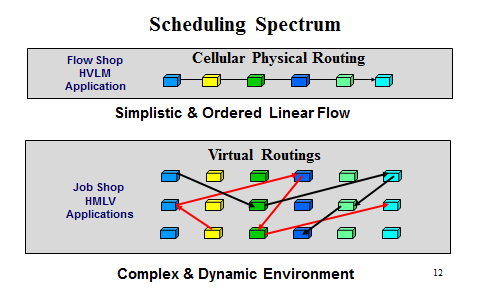Production Scheduling Spectrum
Written by: Bill Kirchmier 7/9/2012
The two graphs represent a range of production scheduling applications varying from simplistic linear flow to complex dynamic scheduling applications. To efficiently schedule this range of applications from High Volume Low Mix (HVLM) to High Mix Low Volume (HMLV) requires very different scheduling techniques. HVLM is the traditional production scheduling model for scheduling simple linear flow applications. Order quantities and inventory requirements were high and cycle times were long. Product flowed from work station to work station in batches until the lot was completed.
This model is no longer competitive; clients are demanding short deliver time, low order quantities, competitive pricing and variety of product. This new HMLV model has been growing over the past ten years and the trend is increasing. Manufacturers that resist the trend and fail to change are at risk.
Computer technology elevated production management to a new level with the introduction of Material Requirement Planning (MRP) in 1970 and established a family of system (MRP, MRP II and ERP). The developers soon realized that capacity resources also needed to be managed.
A new tool named Infinite Capacity Backward Pass (ICBP) scheduling was improvised as a rough cut scheduling solution for capacity resources. ICBP has served for more than forty years as the default method to manage capacity resources, i.e. machines, tools and people for MRP systems ; however fails to deliver feasible schedules.
Now this model is at risk for the HMLV end of the spectrum. This family of systems is referred to as planning and scheduling; however with today’s production environment; the model would be pressed to be considered modern scheduling technology. (Albeit ERP remains the predominant production model.)
Articles about finite scheduling began appearing in the 1960’s. In 1984 three systems were installed by three different developers and this was the beginning of commercial Finite Capacity Scheduling (FCS) systems. FCS was over promoted and led to approximately 200 vendors claiming to support FCS by 1990’s. Ten years later, the list was down to approximately twenty companies that ere successfully marketing and implementing FCS systems.
The growing HMLV market demand for coordinating and synchronizing material and capacity resources in a single system is a motivating factor for FCS systems. FCS systems are now alive and well. In addition to effectively coordinating and synchronizing material and capacity resources; FCS systems calculate start times and finish times for material and capacity resources for every production operation. Not possible for ERP technology.
the good news is; FCS systems now interface with ERP systems and replace traditional dispatch lists with “work center to-do reports” that define both the where needed material requirements and in what quantities. These integrated ERP/FCS systems also define the when needed factor for capacity resources. These combined functions make possible the coordination and synchronization of material and capacity of all work orders throughout the scheduling horizon.
The production trend is toward High Mix Low Volume (HMLV) applications with complex and dynamic routines requiring a high degree of routing flexibility as shown in the virtual routing graphic is continuing to grow. FCS is the efficient solution for scheduling for this scheduling application.
The logic cost effective solution for HVLM applications is the integrated simulation based FCS/ERP model.




